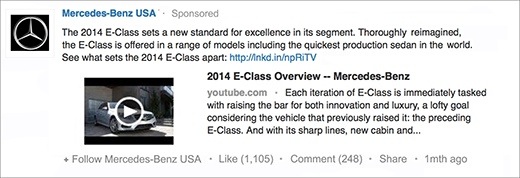In August 2013, Linkedin announced the arrival of a new advertising option called “sponsored updates“. Many current Linkedin advertisers were aware of Linkedin Ads, those small text with image ads that appear when someone searches on linkedin, views a profile, etc. To the delight of marketers, the option to pay for sponsored updates meant the “updates” (ads) would begin to appear along with other news updates in someones home page feed in Facebook and other social media websites.

Sponsored Updates vs. Normal Linkedin Ads
Three more obvious benefits from sponsored updates include;
1. Increased Exposure
Increased visibility due to ad placement in news feed vs. a designated ad spot that people can ignore. Placement is key to getting your ad clicked on. Ads can generate 1,000s of impressions with only a handful or no clicks. A Mashable social profile eye tracking study reveals some interesting insights into how people view their news feed.
![]()
2. Increased Click Through Rates
Due to the placement of the sponsored updates in the news feed, one would assume click through on the updates would be higher than those of the ads. Generally, this is true. We have seen higher click through rates overall.
3. Enhanced Media
As you can see in the example above, advertisers now have the option to include images, videos and other media as part of the ad. Embedding a video or download is a great way to help increase click through performance and generate more activity.
Tips for Improving Sponsored Updates
So you’re ready to jump into sponsored updates head first. If you just started your first Linkedin ad campaign or are looking to test out sponsored updates, here are a few tips you might find helpful.
1. Tag Your Links
Make sure you have some way of tagging your campaign links in analytics. Linkedin Ads may appear in Google Analytics as a campaign but you may need some custom tagging or the visits will appear as Linkedin referring visits.
In Google Analytics, check: Acquisition > Campaigns
It will be much more difficult to track if clicks were a result of the ads. I recommend setting up campaign tagging in Google Analytics for any non-Google ad platform just to be safe. You can do this by using Google’s URL builder tool.
2. Target
Casting too wide of a net can run up your budget fast and result in poor quality leads. If you are on a limited budget, try only a small set of demographics like one age set and a few industries. Limiting your demographics is a great way to test performance. If a campaign seems to be going well, expand your demographics by adding an industry or group. As a rule, I generally start with 500,000-1,000,000+ in each ad audience. Any smaller and you could be limiting your potential for clicks.
As your campaign grows, start testing groups and other demographic features. I recommend keeping the targeting options relatively simple until you learn more about your audience and the opportunities in each group.

There are obviously more managers than there are CEOs so don’t limit your targeting options to just owners and directors.
3. Give it Time
You may see relatively low clicks in the first few weeks after starting your campaign. I would recommend giving the campaign some time to bake into Linkedin. Just like any other form of advertising, it can take several weeks or even months to see a good response or return on your ad spend. Since the first round of ads, targeting and bids will be mainly a test, your campaigns will need some time to optimize. A good campaign manager will make small changes to your campaign over time to maximize ad spend and increase your click through performance.

Good Luck!
With Linkedin sponsored updates and other social media advertising being relatively new as a marketing channel, you should expect to see some experimentation. Make sure you have an advertising budget that allows for some experimentation and good luck!
